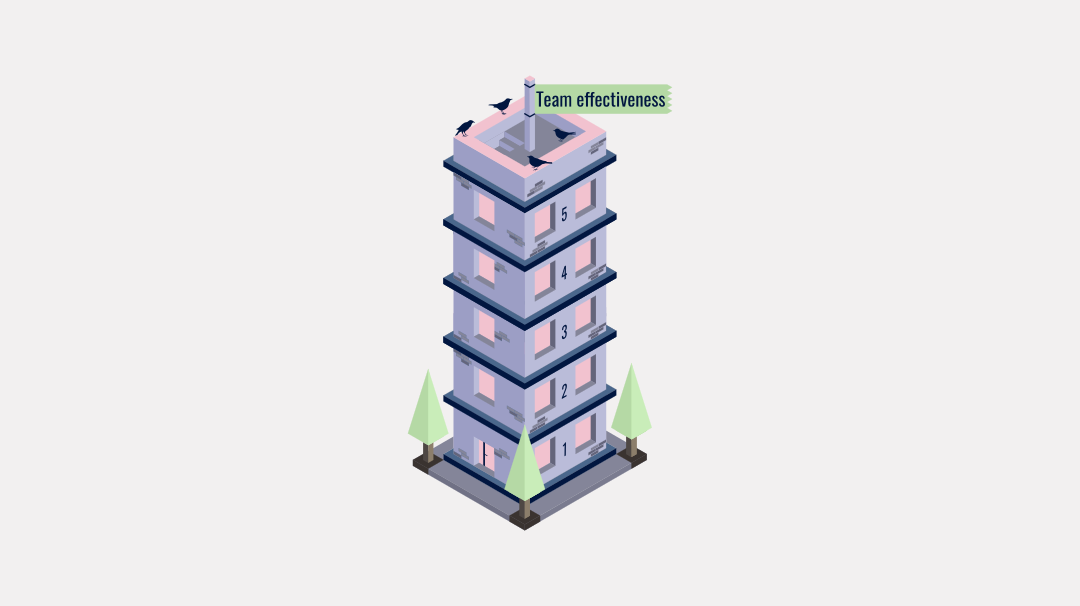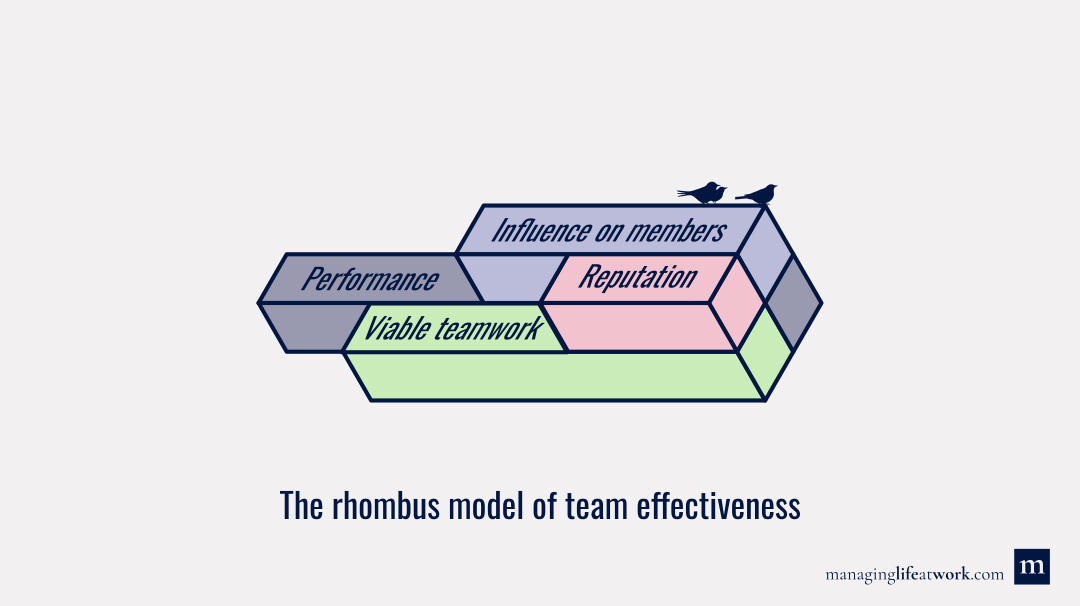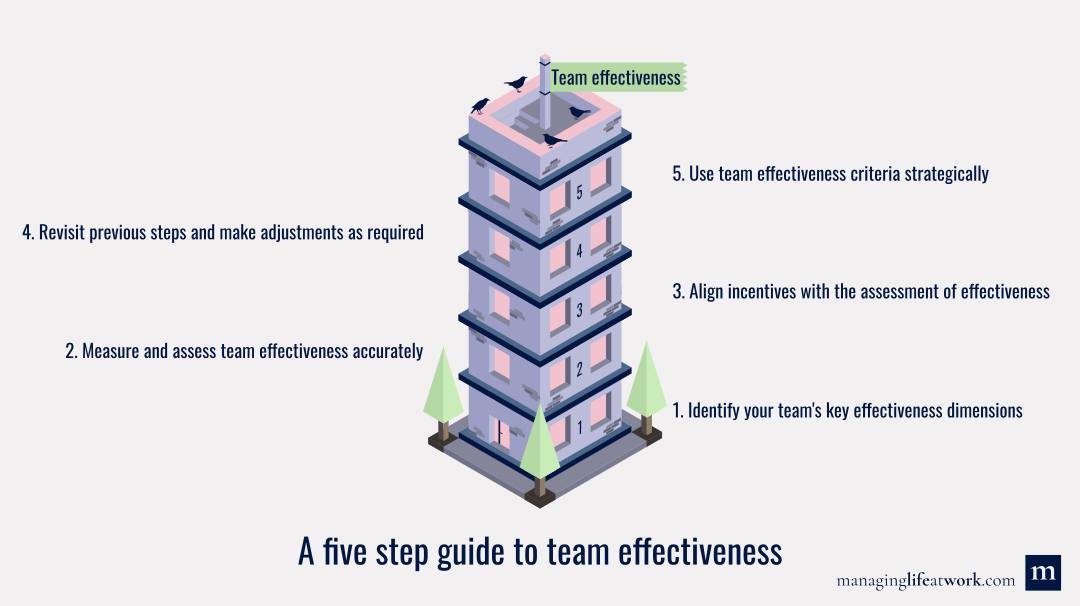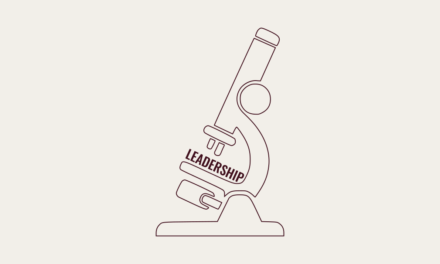Highly effective teams understand the steps that are required to improve team effectiveness.
These steps entail understanding the key elements of effectiveness in an organization; assessing team effectiveness accurately; aligning rewards with team effectiveness assessments; understanding that team effectiveness requires continuous effort; and using team effectiveness criteria strategically.
Read on for details on each of the 5 steps required to achieve team effectiveness and on how to surpass the challenges that come with each step.
Table of contents
- 5 steps to improve team effectiveness
- Step 1: Identify the effectiveness dimensions that matter the most to your team and organization
- Step 2: Measure and assess team effectiveness accurately
- Step 3: Align rewards and incentives with the assessment of team effectiveness
- Step 4: Revisit the three initial steps and make adjustments as required
- Step 5: Use team effectiveness criteria strategically
- Conclusion
- References and further reading
5 steps to improve team effectiveness
Team effectiveness is the extent to which a team produces outputs that are valued by the team members and by other parties (such as supervisors, suppliers, and customers).
The 5 steps below are an evidence-based guide to improve team effectiveness.
Before going any further, consider checking our post on team effectiveness to better understand what team effectiveness is, and its key dimensions and measures.
Step 1: Identify the effectiveness dimensions that matter the most to your team and organization
Team effectiveness has a hierarchical structure: Measures of team effectiveness at the base, specific dimensions of effectiveness in the middle, and a small number of global dimensions at the apex. The first step of this guide entails delineating this hierarchy in a way that makes sense to your team and organization.
The key point here is to build a balanced profile of effectiveness dimensions that are critical to your team’s functioning and to the multiple constituencies of your team (for example team members, company, clients).
Identify the most relevant global dimensions of team effectiveness
Most teams start at the apex of the hierarchy, by identifying the global dimensions that are most important and aligned with the nature of their work. Although we advocate that most teams should consider all four global dimensions of team effectiveness (that is performance, viable teamwork, influence on members, and reputation), in some cases a simpler approach may suffice. For instance, dealing with reputation issues can be a major concern to management teams, but less relevant to time-limited project teams, assembled to produce a one-time product or service.
Note that building a balanced profile of team effectiveness takes practice and is not always intuitive. For instance, given that project teams disband once the project is concluded, team performance tends to be the more obvious dimension to consider. However, members’ professional growth can be equally important, because it sustains the long-term success of the company[1] – if team members grow professionally in one project team, they will likely perform better in the next project team (team performance), and even share their knowledge with their new peers (viable teamwork).
Go through the team effectiveness model depicted below and ask yourself why you would need to consider each global dimension of team effectiveness. While doing this, keep in mind that these dimensions are in constant interplay. For example, viable teamwork (whether a team has in place the processes and states necessary to achieve its goals and keep operating) is an important predictor of team effectiveness[2].
Thus, even if a global dimension seems irrelevant to your team, make sure it does not have hidden implications for the dimensions you care most about.
Identify the specific dimensions that better delineate each global dimension of team effectiveness
Each global dimension of your team’s effectiveness can then be delineated into unique specific dimensions, depending on factors such as:
- Type of work currently performed (specific dimensions of team effectiveness most relevant in the short run);
- Forecasts of the work that will be required from your team in the future (dimensions of team effectiveness that are most relevant in the long run);
- Type of team (such as production team, top management team, project team, customer service team);
- Team constituencies for whom the output is relevant (such as team members, managers, clients);
- Goals, objectives, and strategy of the company.
For example, the performance of a top management team may be delineated in terms of the financial results of the firm. In contrast, a customer service team may delineate team performance based on customer satisfaction and productivity. Likewise, if a customer service team will deal with a new product in the near future, you might want to temporarily tone down the importance of productivity and focus on collective learning (from the “viable teamwork” global dimension). This would give room for team members to familiarize themselves with the new product and to actually share that knowledge in the team.
An important consideration in this step is whether the goals of all parts are aligned[3a]. That is, whether the goals of team members are aligned with those of the team, whether team goals contribute to the success of the company, and whether the company goals add value to customers. Attending to the four global dimensions of team effectiveness of the rhombus model helps you consider the goals of most teams’ key constituencies, most likely exposing the extent to which their goals are aligned.
In most instances, teams benefit from assessing multiple specific dimensions for each global dimension of effectiveness. Take the case of the global dimension of team performance, which can be delineated based on team productivity, efficiency, quality, or innovativeness. A productive and efficient team, delivering low quality outputs will see its overall effectiveness undermined, and will lose clients over time. Similarly, a team meeting quantity and quality standards, but failing to innovate may be unable to keep up with times and will eventually stop meeting customers’ needs.
Challenges associated with selecting and delineating effectiveness dimensions
On the surface this first step appears to be simple. You look at your team and identify the effectiveness dimensions that reflect the critical success factors for multiple constituencies.
However, unveiling these success factors can be challenging for at least two reasons. First, what is said and what is done are sometimes two different things[4]. Take the case of Hewlett-Packard. In the 1980s they touted “The HP Way” to promote company values such as collaborative teamwork and trust. However, engineers found that politics and fierce competition were the success factors to get ahead and get along in the company. So, make sure the espoused dimensions of effectiveness are those that are truly and actually in place when important decisions are made.
Second, in some cases, it is almost impossible to conciliate contradictory dimensions of team effectiveness. For example, achieving the highest quality at the lowest cost is likely unfeasible. Likewise, having the highest concern for all team constituencies may be challenging. In ambiguous or contradictory circumstances like these, successful CEOs reported benefits in taking the time to collect more information, reflect, question what truly is in place, and think creatively about how to solve or dissolve the contradiction[5]. This questioning and reflection process may give you the opportunity to discover common ground among your team’s constituencies that would dissolve the contradiction.
Step 2: Measure and assess team effectiveness accurately
Once you have identified the dimensions of effectiveness that matter the most for the relevant constituencies of your team, it is time to develop measures, collect accurate information for each effectiveness dimension, and use those measurements as key effectiveness indicators for assessing how well your team is doing in its critical success factors.
This is the final stage of team effectiveness delineation, and ultimately will define what really matters for your team. It is at this stage that you turn an abstract effectiveness dimension into a concrete and measurable goal to be accomplished.
Clearly defining how to measure team effectiveness has the benefit of leaving your team members on the same page regarding, for instance, what to accomplish, what to prioritize, the means to achieve goals, and individual roles and responsibilities. In turn, being on the same page boosts your team’s confidence in itself, effort, proactive behavior, and ultimately effectiveness[6] [7].
To have an entire team on the same page, it is important to open the door and ask team members to have an active role in the selection and development of the team effectiveness measures that will be used. Team supervisors tend to have a better knowledge of the specific dimensions of team effectiveness that matter the most, since they have direct access to the strategic goals of the company. However, team members tend to have a more rich and nuanced view of their work and, as such, can provide valuable information to develop and implement effectiveness measures[3b].
Types of team effectiveness measures
Objective measures of team effectiveness are typically quantifiable and specific (for example, number of pieces produced). Subjective measures of team effectiveness are typically collected by surveying or interviewing team members, supervisors, customers, or other external observers (for example, supervisors’ ratings of team performance).
Measures based on results focus of the consequences or outputs of teamwork (for example, number of sales). Effectiveness measures based on behavior focus on the actions and processes of teams at work (for example, whether team members cooperate and exchange knowledge to make more sales).
The distinction between absolute measures and relative ones lies in whether the effectiveness of others counts. In relative measures, your team’s effectiveness is compared to the effectiveness of other teams (for example, your team was the most efficient in the company). In absolute measures, others’ effectiveness is out of the equation – team effectiveness is assessed against a standard that your team may, or may not, achieve (for example, the productivity target is 100 sales per day and your team made 102 sales, thus succeeding).
These differences in team performance measures might be subtle, but they have important implications for how you manage team effectiveness. For instance, relative measures tend to increase competition, even in cases where cooperation would be the optimal route. In contrast, absolute measures tend to boost cooperation, even in cases where competition would be expected[11]. Measures based on objective results may ignore external factors that are outside the control of the team, and create a sense of injustice among team members[12]. Further, despite their apparent objectivity, the same objective result may mean different things to different teams. For example, while a low number of complains may be a reason to celebrate for a mass production product, it may be a reason for concern if you are dealing with a luxurious product. Finally, while subjective measures are a great source of information on the perceptions of people, these measures can be contaminated by human biases.
In most instances, it is beneficial to triangulate the information derived from different types of measures. Take the case of objective and subjective measures of effectiveness. While the number of certifications can objectively inform you about the growth of your team members, those certifications may be subjectively perceived by team members as a burden with no growth value.
Likewise, collecting subjective measures of team effectiveness from multiple sources is also advisable. For example, while team members may be satisfied with the team’s innovation rate, customers may feel that the new products lack the innovative edge of previous products. In cases like these, discussing the discrepancies between measures and sources can help you gain insights on next steps, the expectations of customers, and the real nature of your team’s work.
While deciding on your team effectiveness measures, keep in mind that there is no such thing as a perfect measure or source. Each measure and source may be more or less accurate depending on the dimension of effectiveness you want to assess, how well the measure fits your team’s work, and the quality of the measure, among many other factors. Thus, the decision on the most accurate measure and source to rely on should be done on a case by case basis.
Challenges associated with measuring and assessing team effectiveness
Given that this final delineation of team effectiveness will focus your team’s attention on the agreed upon and selected key effectiveness indicators, it is paramount that you go through this stage as precisely as possible. However, for multiple practical reasons, you may not always have the resources to access the most accurate and direct sources of information. To this end, there is some scientific evidence that can assist you in dealing with the challenge of measuring and assessing team effectiveness accurately when, in the real world, you do not have infinite resources.
Ideally you should strive for the most direct measures of each team effectiveness dimension. For instance, objective indicators (such as time spent in a call, or percentage of sales growth) are accurate measures of team performance, whereas subjective impressions of team members and supervisors (such as anonymous team satisfaction surveys) are among the most direct and accurate ways to capture teamwork viability.
In situations where it might not be feasible to collect such direct data, you may collect indirect information and still have an accurate and representative assessment of team effectiveness. For instance, research suggests that teams tend to be aware of their performance and reputation levels, as their subjective assessments converge with objective measures[13] [14a] and with external assessments[15] [16] of performance and reputation. Similarly, since customers can easily notice how satisfied team members are[17], a customer satisfaction measure can give you direct information regarding the performance of your team, and indirect information on teamwork viability and team’s influence on members.
A related challenge is whether you should look at the average of all dimensions of team effectiveness, or look at each dimension individually. Each option has merits and demerits, and if you look at both you can cancel out the demerits of each one.
An average measure gives you an overall picture of what is happening in the team, and since most teams nowadays perform multiple tasks, it makes sense to see how effective the team is in all its duties[18].
However, averages (even when weighted by importance) can mask specific liabilities in the effectiveness of your team and hinder your ability to improve the situation. We know, for instance, that members’ satisfaction with the team can be enhanced mainly by emphasizing learning and skill development goals, and team performance depends more on emphasizing performance goals and external competition[14b]. By knowing which dimension of team effectiveness is faulty, you improve the likelihood of solving the issue with a targeted intervention.
Although measures of effectiveness can have defects and limitations, it is better to have measures in place than to overlook the evaluation of your team effectiveness. Only by examining how effective your team is now can you reliably and reasonably determine how effective your team should be in the future.
Step 3: Align rewards and incentives with the assessment of team effectiveness
This step is about adding rewards and incentives to the effectiveness measures your team is using. While this is not a required step to delineate team effectiveness, it is an important step to enhance the effectiveness of your team.
There are two main benefits to this step: Incentive benefits and sorting benefits[9b]. Incentive benefits relate to the motivation boost your team gets from being rewarded – the more team members believe they can achieve a certain effectiveness level and the more they value the reward, the more they will make an effort. Large scale studies indicate that when teams are rewarded based on effectiveness, their effectiveness tends to be enhanced[19a] [20].
Sorting benefits relate to the impact rewards have on the composition of your team. For instance, by rewarding innovation your team may attract and keep innovative members, and loose those who are unable or unwilling to engage in innovative efforts. How you define and reward team effectiveness influences the profile of the people who are willing to join and stay in your team.
Although there are important nuances in how to put together a team-based reward system, large scale studies[19b] [21a] indicate that:
- Team rewards tend to be preferred over individual rewards to stimulate team effectiveness;
- Team rewards are more effective for highly interdependent work and individual rewards for highly independent work;
- Rewards distributed equitably (based on the contribution of each team member) tend to be more effective than those distributed equally (all members get the same, regardless of input or effort).
Challenges associated with aligning rewards and incentives with the assessment of team effectiveness
In order to put together a well-articulated reward system for your team, you have to consider multiple, and sometimes conflicting, aspects.
Let’s say that, in an attempt to boost the performance and reputation of your team, you develop a system where team rewards are closely connected to these two dimensions of effectiveness. In principle, this is great. The challenge may come, however, if a reputation criterion clashes with a performance one. For example, you may find that spending more time supporting clients boosts the reputation of your team at the cost of team productivity and immediate profit margins (reduced team performance). As a result, you may have, inadvertently, created a dilemma to your team such that members are faced with a conflict between achieving performance or reputation. If undetected and unresolved, this dilemma may communicate that, regardless of effort, the team will never be able to meet the effectiveness thresholds and obtain the expected rewards.
There is also some evidence indicating that the motivational boost of team reward systems tends to dissipate over time. As time goes by, team members get used to the reward system, begin to take it for granted, and some even start finding ways to game it[22]. In practical terms, this tells you that revising and updating team reward systems is a must. However, constant updates come at a cost. For instance, the productivity thresholds can become unachievable, and the level of rewards can become unsustainable to the company.
Further, it can also be challenging to calibrate the right level of a reward. For instance, rewards with a raise below 7% are largely unnoticed and can even be detrimental to your team’s effectiveness[23] [24]. You may also notice that high rewards may be so attractive to teams that they start attending only to the effectiveness dimensions that are highly rewarded, and disregard the less rewarded dimensions of effectiveness.
In the video below, the American Psychological Association’s Center for Organizational Excellence shares some additional insights on how to successfully reward and recognize employees’ efforts at work:
Step 4: Revisit the three initial steps and make adjustments as required
Since most work is dynamic it tends to be a good idea to check, on a regular basis, whether the effectiveness criteria you are using are still relevant and accurate. That is, your team will most likely need to change the weight to, add, or even delete dimensions and measures of team effectiveness over time[21b] [25].
Most teams define goals, milestones, and deliverables at the beginning of a project or a task. This tends to be a good practice as it motivates the team to actually do it[26a]. Notwithstanding, as a team progresses with a project or a task, new information usually comes to light. For instance, unexpected changes in your context may turn a type of project your team aces into a difficult challenge with multiple unforeseen obstacles. Unless you revise the criteria you use to assess team effectiveness, your team may end up with a poor evaluation when in reality it thrived. Just make sure your revision is a reflection of the changes detected in the task and not an excuse to postpone the output.
Also, since teams mature over time[26b], a key effectiveness indicator at one moment in time may be a liability at another time. For example, you may learn that accentuating viable teamwork was beneficial in the early stages of your team, but a source of distraction later on, once viable teamwork is already in place and the team is trying to focus on its performance indicators.
Another example on the importance of revising dimensions and measures of team effectiveness is when fostering one dimension hinders another. For instance, an excessive focus on team performance may lead your team members to ignore unrewarded tasks that may be critical to sustain performance (helping each other out, for instance)[9c]. Likewise, if your measures of team effectiveness only encourage cooperation between team members and create competition between teams, your company may lose viable resources that come from cooperation between teams[27].
Challenges associated with revisiting dimensions and measures of team effectiveness
Most teams face three main challenges when revising dimensions and measures of team effectiveness. First, changes in performance measures may raise concerns on whether team members’ previous effectiveness is going to be recognized and rewarded[9d]. To avoid this, it is important to be clear about the time-frame of a measure, to be consistent in how you apply the measures, and to reward previous effectiveness even if new measures are now in place.
Second, teams do not always have access to the necessary resources to redesign and change effectiveness measures. Time, budget, advanced training, and support from top management are examples of resources that may not be available to properly manage team effectiveness. With limited resources, changing team effectiveness measures can become an additional source of pressure and stress to team members and supervisors. The demands of teamwork can even be intensified if the new measure of effectiveness is about efficiency; that is, a measure aimed at improving the productivity of your team. Research has found that when teamwork becomes a source of pressure and a demand to work more hours, the well-being of team members suffers[28].
Finally, ensuring that everyone is on board with the changes in the criteria used to evaluate team effectiveness is not always straightforward. Changes in how team effectiveness is assessed tend to go hand in hand with changes in the formal and informal roles of team members. For instance, a member who gains an informal leadership position due to unique expertise may become redundant if that expertise is no longer important for the new team effectiveness criteria.
Established ways to deal with this resistance to change in effectiveness criteria include:
- Involving team members in the development of new effectiveness measures[3c];
- Providing a reasonable explanation for the change[29];
- Emphasizing team rewards (particularly if the change reflects increased teamwork)[30];
- Having clear goals for the change that are aligned with the values of the team and organization[31].
Step 5: Use team effectiveness criteria strategically
This last step is mainly about politics and strategy. Hard work and meeting team effectiveness thresholds are important, but they are only one piece of the long-term success puzzle. Other important pieces, like your political skill and how strategic you are, can be equally important[32]. For instance, those who master political skills (like knowing how to position themselves socially, mastering networks, and understanding and managing other people well), tend to advance faster in their careers[33]. Likewise, high-level strategic thinking is one of the competencies that more clearly distinguish executives from non-executives[34].
How can you be strategic and political about your team effectiveness? In the previous steps, you most likely identified the effectiveness priorities of each team constituency (such as team members, clients, and top management). Now, you can strategically highlight each dimension of effectiveness to the people who care the most about it. For instance, there is no substantial benefit in highlighting how satisfied your team members are to top management, if their focus is on productivity, efficiency, and quality.
Highlighting the information of most relevance to each constituency of your team is not only political and strategic, but it also saves time and may even create resources. For example, companies with highly reputable top management teams tend to attract more (and better) job applicants[35], and to have employees who are more identified with the company[36]. By highlighting reputation aspects (an effectiveness dimension) to relevant team constituencies (potential job applicants and current employees), top management teams are able to work with and retain the most talented professionals. Likewise, politically skilled and well connected leaders tend to have access to additional resources, upon which their teams can capitalize on[37]. Indeed, large scale studies show that most people throughout the world do not appreciate lone and poorly connected leaders[38].
Challenges associated with using team effectiveness criteria strategically
Being strategic and skillful politically is neither positive nor negative. These are neutral competencies that can have positive or negative consequences, depending on their underlying intentions, applications, and consequences[39]. For instance, when overdone, politics tends to have performance costs – team members may spend more time networking, promoting the team, and competing for resources rather than working[40]. So, the main challenge with this step is to find the right level of politic behavior that will most likely help the team achieve its effectiveness goals.
A related challenge is whether you can draw a clear line between strategic political behavior and shady political behavior. Honest and transparent strategic political behavior communicates trustworthiness and creates an environment where trust and collaborative work can be fostered in your team and company[41]. Shady political behavior not only undermines trust and cooperative work, but also communicates to other team members that shady, selfish, and unethical behaviors are acceptable[42]. For instance, while highlighting relevant information to specific team constituencies is strategic, political, and likely welcomed; taking credit for other teams’ work is a shady political strategy that undermines teamwork and should be avoided.
Conclusion
To enhance the probability of improving team effectiveness, we outlined an evidence-based guide, laid out in 5 steps, on how to define, measure, and reward team effectiveness.
We note, however, that it is important to distinguish between taking the steps to improve team effectiveness and obtaining improved results. While the whole point of these five steps is to increase the probability of improved results, there are many other factors affecting your team’s results. In some cases, you may, for example, delineate and reward team effectiveness poorly and still have enhanced results due to luck or good fortune.
As always, we thank you for trusting your time with ManagingLifeatWork.com. Until next time, keep improving the effectiveness of your team.
References and further reading
- ^ Edmondson, A. C., and Harvey, J.-F. (2018). “Cross-boundary teaming for innovation: Integrating research on teams and knowledge in organizations“. Human Resource Management Review, 28, 347–360.
- ^ Elms, A. K., Harjinder, G., and a Gonzalez-Morales, M. G. (2023). “Confidence is key: Collective efficacy, team processes, and team effectiveness“. Small Group Research, 54, 191–218.
- ^ a b c Aguinis, H., Gottfredson, R. K., and Joo, H. (2013). “Avoiding a “me” versus “we” dilemma: Using performance management to turn teams into a source of competitive advantage“. Business Horizons, 56, 503–512.
- ^ Schein, E. H. (2010). “Organizational culture and leadership” (4. ed.). San Francisco, CA: Jossey-Bass.
- ^ McKenzie, J., Woolf, N., van Winkelen, C., and Morgan, C. (2009). “Cognition in strategic decision making: A model of non‐conventional thinking capacities for complex situations“. Management Decision, 47, 209–232.
- ^ Aubé, C., Rousseau, V., and Tremblay, S. (2015). “Perceived shared understanding in teams: The motivational effect of being ‘on the same page’”. British Journal of Psychology, 106, 468–486.
- ^ Aubé, C., Rousseau, V., Brunelle, E., and Marques, D. (2018). “The relevance of being “on the same page” to succeed as a project team: A moderated mediation model“. Motivation and Emotion, 42, 804–815.
- ^ Beal, D. J., Cohen, R. R., Burke, M. J., and McLendon, C. L. (2003). “Cohesion and performance in groups: A meta-analytic clarification of construct relations“. Journal of Applied Psychology, 88, 989–1004.
- ^ a b c d Conroy, S. A., and Gupta, N. (2016). “Team pay-for-performance: The devil is in the details“. Group & Organization Management, 41, 32–65.
- ^ Delgado Piña, M. I., Romero Martínez, A. M., and Gómez Martínez, L. (2008). “Teams in organizations: a review on team effectiveness“. Team Performance Management: An International Journal, 14, 7–21.
- ^ Woike, J. K., and Hafenbrädl, S. (2020). “Rivals without a cause? Relative performance feedback creates destructive competition despite aligned incentives“. Journal of Behavioral Decision Making.
- ^ Gerhart, B., Rynes, S. L., and Fulmer, I. S. (2009). “Pay and performance: Individuals, groups, and executives“. Academy of Management Annals, 3, 251–315.
- ^ Jehn, K. A., Northcraft, G. B., and Neale, M. A. (1999). “Why differences make a difference: A field study of diversity, conflict, and performance in workgroups“. Administrative Science Quarterly, 44, 741–763.
- ^ a b Mehta, A., and Mehta, N. (2018). “Knowledge integration and team effectiveness: A team goal orientation approach“. Decision Sciences, 49, 445–486.
- ^ Tyran, K. L., and Gibson, C. B. (2008). “Is what you see, what you get? The relationship among surface- and deep-level heterogeneity characteristics, group efficacy, and team reputation“. Group & Organization Management, 33, 46–76.
- ^ Hoogeboom, M. A. M. G., and Wilderom, C. P. M. (2020). “A complex adaptive systems approach to real-life team interaction patterns, task context, information sharing, and effectiveness“. Group & Organization Management, 45, 3–42.
- ^ Cohen, S. G., and Bailey, D. E. (1997). “What makes teams work: Group effectiveness research from the shop floor to the executive suite“. Journal of Management, 23, 239–290.
- ^ Mathieu, J. E., and Gilson, L. L. (2012). “Criteria issues and team effectiveness“. In S. W. J. Kozlowski (Ed.), Oxford Handbook of Industrial and Organizational Psychology (pp. 910–930). London, UK: Oxford University Press.
- ^ a b Garbers, Y., and Konradt, U. (2014). “The effect of financial incentives on performance: A quantitative review of individual and team-based financial incentives“. Journal of Occupational and Organizational Psychology, 87, 102–137.
- ^ Nyberg, A. J., Maltarich, M. A., Abdulsalam, D., Essman, S. M., and Cragun, O. (2018). “Collective pay for performance: A cross-disciplinary review and meta-analysis“. Journal of Management, 44, 2433–2472.
- ^ a b Heider, A.-K., and Mang, H. (2020). “Effects of monetary incentives in physician groups: A systematic review of reviews“. Applied Health Economics and Health Policy.
- ^ Obloj, T., and Sengul, M. (2012). “Incentive life-cycles: Learning and the division of value in firms“. Administrative Science Quarterly, 57, 305–347.
- ^ Mitra, A., Gupta, N., and Jenkins, G. D. (1997). “A drop in the bucket: When is a pay raise a pay raise?“. Journal of Organizational Behavior, 18, 117–137.
- ^ Mitra, A., Jenkins, G. D., Gupta, N., and Shaw, J. D. (2015). “The utility of pay raises/cuts: A simulation experimental study“. Journal of Economic Psychology, 49, 150–166.
- ^ Meyer, C. (1994). “How the right measures help teams excel“. Harvard Business Review, 72, 95–103.
- ^ a b Larson, N. L., McLarnon, M. J. W., and O’Neill, T. A. (2020). “Challenging the “static” quo: Trajectories of engagement in team processes toward a deadline“. Journal of Applied Psychology.
- ^ Scott, S. G., and Einstein, W. O. (2001). “Strategic performance appraisal in team-based organizations: One size does not fit all“. Academy of Management Executive, 15, 107–116.
- ^ Ogbonnaya, C. (2019). “Exploring possible trade‐offs between organisational performance and employee well‐being: The role of teamwork practices“. Human Resource Management Journal, 29, 451–468.
- ^ Deci, E. L., Eghrari, H., Patrick, B. C., and Leone, D. R. (1994). “The self-determination theory“. Journal of Personality, 62, 119–142.
- ^ Barnes, C. M., Hollenbeck, J. R., Jundt, D. K., DeRue, D. S., and Harmon, S. J. (2011). “Mixing individual incentives and group incentives: Best of both worlds or social dilemma?“. Journal of Management, 37, 1611–1635.
- ^ Lane, G. (2008). “Organizational change: The challenge of supporting staff“. Business Information Review, 25, 262–267.
- ^ Ferris, G. R., Treadway, D. C., Kolodinsky, R. W., Hochwarter, W. A., Kacmar, C. J., Douglas, C., and Frink, D. D. (2005). “Development and validation of the political skill inventory“. Journal of Management, 31, 126–152.
- ^ Zinko, R., Ferris, G. R., Humphrey, S. E., Meyer, C. J., and Aime, F. (2012). “Personal reputation in organizations: Two-study constructive replication and extension of antecedents and consequences“. Journal of Occupational and Organizational Psychology, 85, 156–180.
- ^ Wille, B., Wiernik, B. M., Vergauwe, J., Vrijdags, A., and Trbovic, N. (2018). “Personality characteristics of male and female executives: Distinct pathways to success?“. Journal of Vocational Behavior, 106, 220–235.
- ^ Turban, D. B., and Cable, D. M. (2003). “Firm reputation and applicant pool characteristics“. Journal of Organizational Behavior, 24, 733–751.
- ^ Smidts, A., Pruyn, A. H., and Van Riel, C. B. M. (2001). “The impact of employee communication and perceived external prestige on organizational identification“. Academy of Management Journal, 49, 1051–1062.
- ^ Blass, F. R., and Ferris, G. R. (2007). “Leader reputation: The role of mentoring, political skill, contextual learning, and adaptation“. Human Resource Management, 46, 5–19.
- ^ Javidan, M., Dorfman, P. W., de Luque, M. S., and House, R. J. (2006). “In the eye of the beholder: Cross cultural lessons in leadership from project GLOBE“. Academy of Management Perspectives, 20, 67–90.
- ^ Ahearn, K. K., Ferris, G. R., Hochwarter, W. A., Douglas, C., and Ammeter, A. P. (2004). “Leader political skill and team performance“. Journal of Management, 30, 309–327.
- ^ Zettler, I., and Lang, J. W. B. (2015). “Employees’ political skill and job performance: An inverted U-shaped relation?“. Applied Psychology, 64, 541–577.
- ^ Dayan, M., and Benedetto, C. A. (2010). “The impact of structural and contextual factors on trust formation in product development teams“. Industrial Marketing Management, 39, 691–703.
- ^ Felps, W., Mitchell, T. R., and Byington, E. (2006). “How, when, and why bad apples spoil the barrel: Negative group members and dysfunctional groups“. Research in Organizational Behavior, 27, 175–222.









